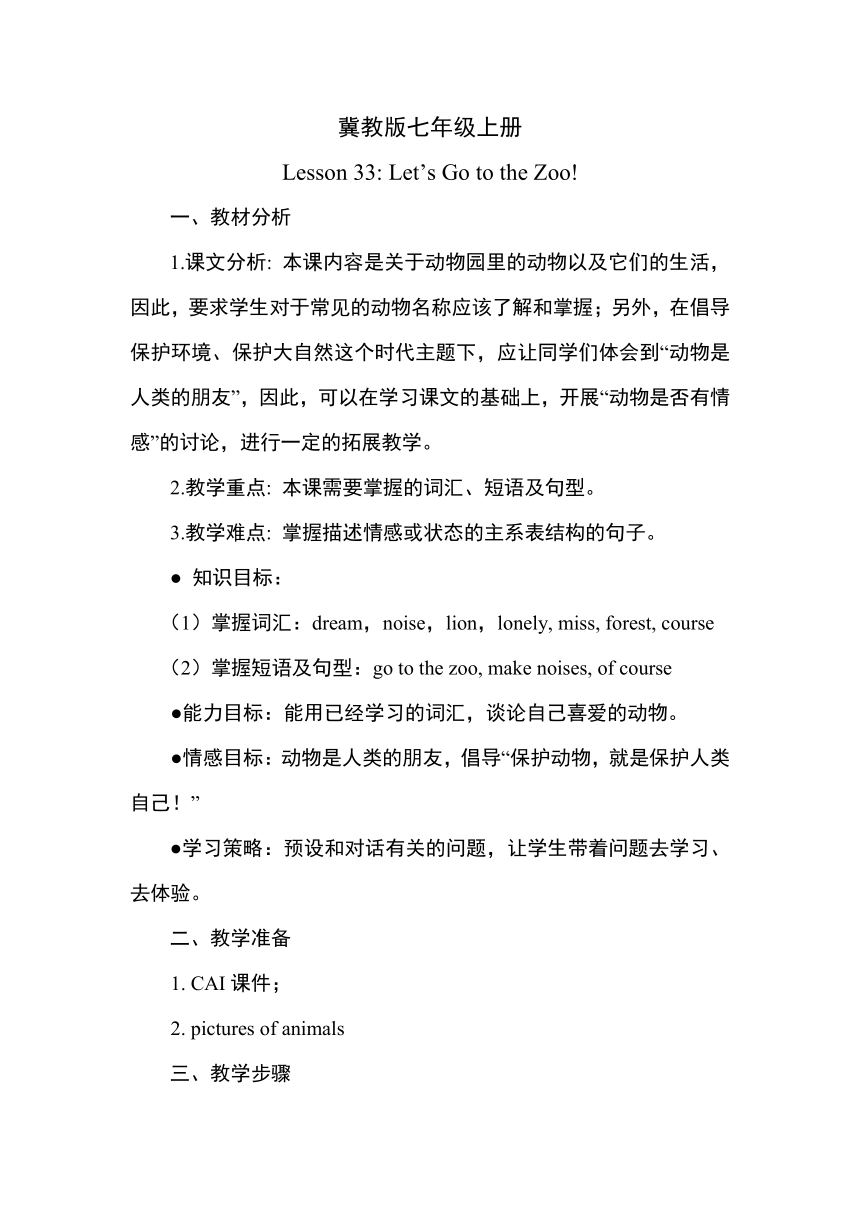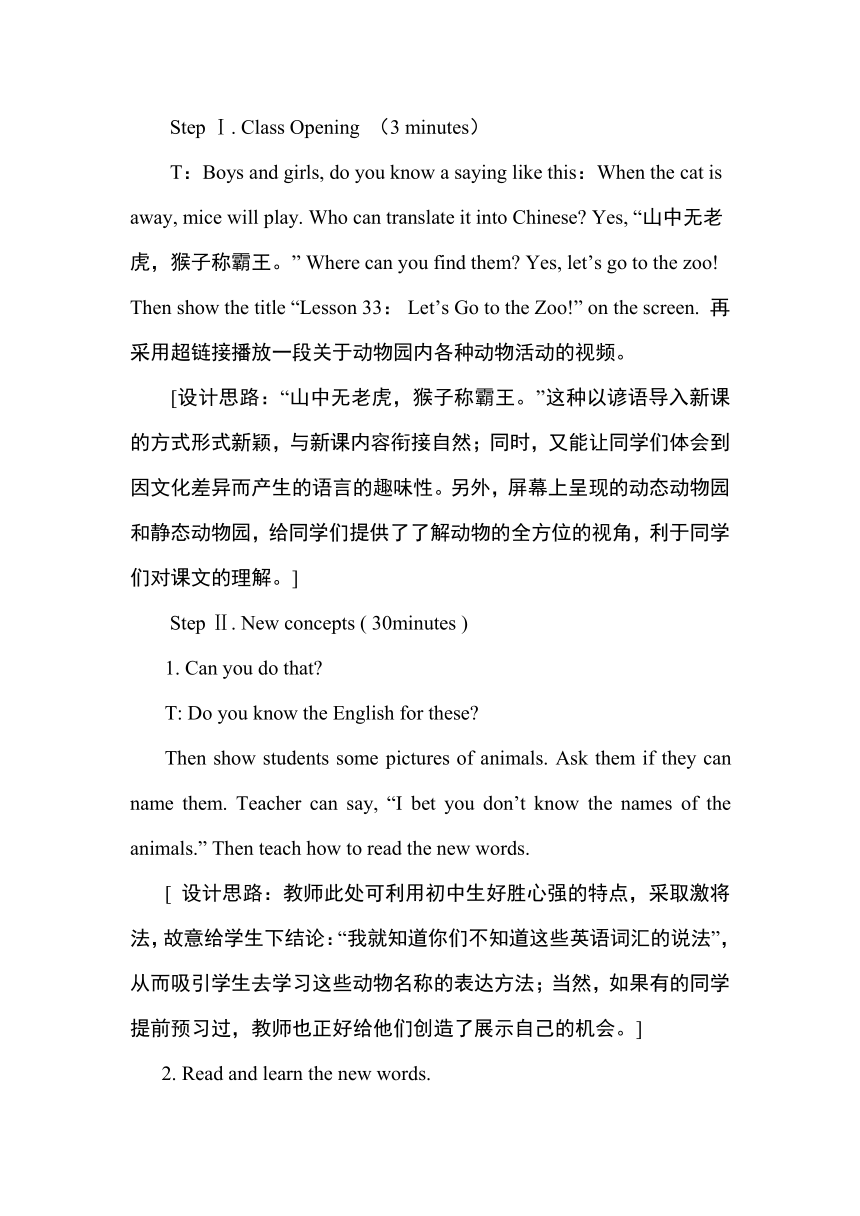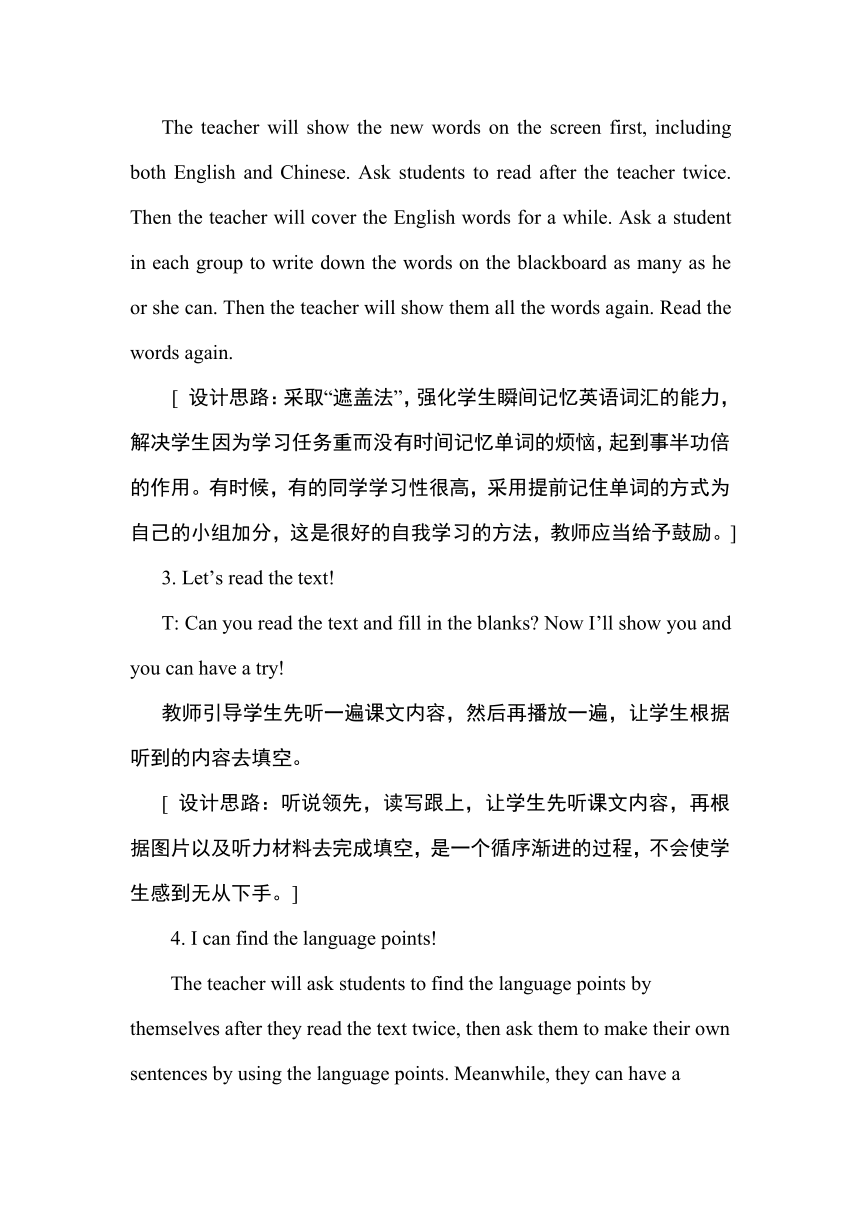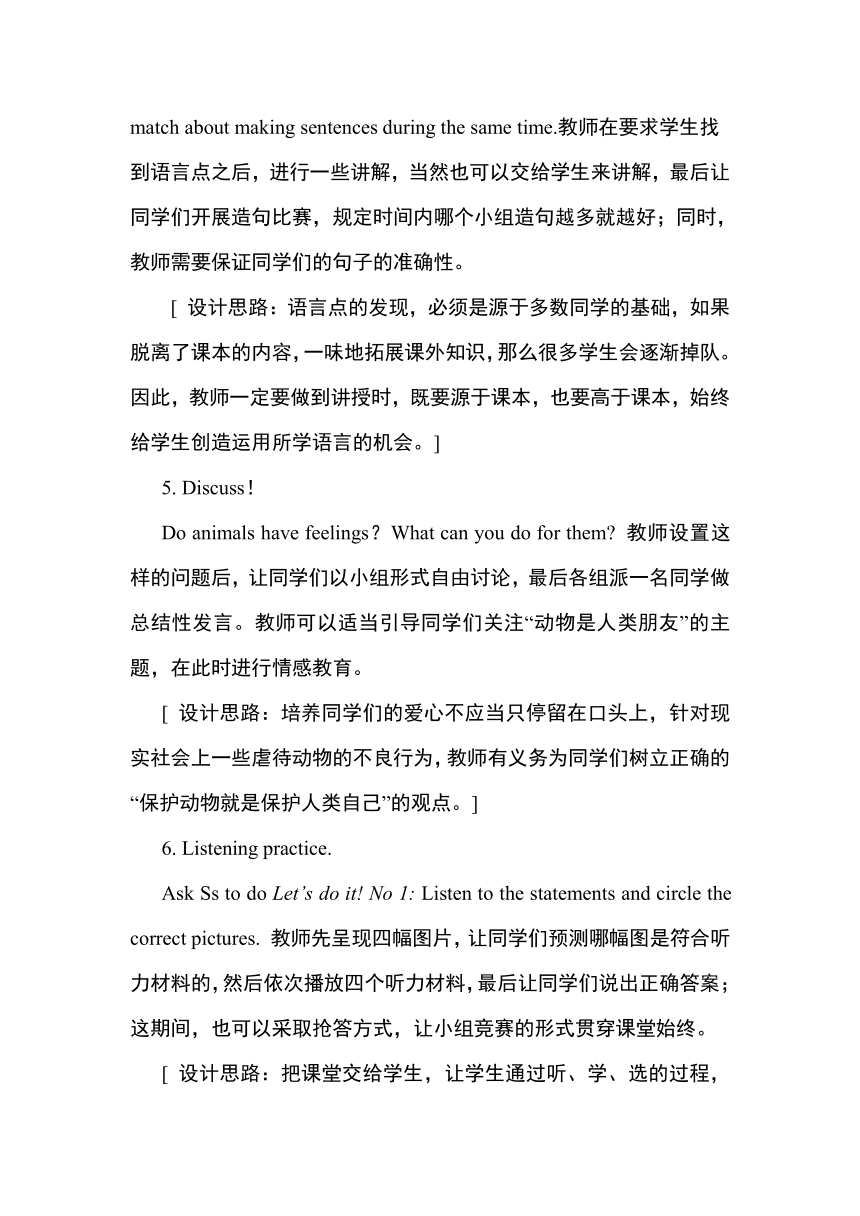Unit 6 Let’s Go! Lesson 33 Let’s Go to the Zoo! 教案
文档属性
| 名称 | Unit 6 Let’s Go! Lesson 33 Let’s Go to the Zoo! 教案 |  | |
| 格式 | zip | ||
| 文件大小 | 15.9KB | ||
| 资源类型 | 教案 | ||
| 版本资源 | 冀教版 | ||
| 科目 | 英语 | ||
| 更新时间 | 2016-08-23 06:50:05 | ||
图片预览




文档简介
冀教版七年级上册
Lesson
33:
Let’s
Go
to
the
Zoo!
一、教材分析
1.课文分析:
本课内容是关于动物园里的动物以及它们的生活,因此,要求学生对于常见的动物名称应该了解和掌握;另外,在倡导保护环境、保护大自然这个时代主题下,应让同学们体会到“动物是人类的朋友”,因此,可以在学习课文的基础上,开展“动物是否有情感”的讨论,进行一定的拓展教学。
2.教学重点:
本课需要掌握的词汇、短语及句型。
3.教学难点:
掌握描述情感或状态的主系表结构的句子。
●
知识目标:
(1)掌握词汇:dream,noise,lion,lonely,
miss,
forest,
course
(2)掌握短语及句型:go
to
the
zoo,
make
noises,
of
course
●能力目标:能用已经学习的词汇,谈论自己喜爱的动物。
●情感目标:动物是人类的朋友,倡导“保护动物,就是保护人类自己!”
●学习策略:预设和对话有关的问题,让学生带着问题去学习、去体验。
二、教学准备
1.
CAI课件;
2.
pictures
of
animals
三、教学步骤
Step
Ⅰ.
Class
Opening
(3
minutes)
T:Boys
and
girls,
do
you
know
a
saying
like
this:When
the
cat
is
away,
mice
will
play.
Who
can
translate
it
into
Chinese
Yes,
“山中无老虎,猴子称霸王。”
Where
can
you
find
them
Yes,
let’s
go
to
the
zoo!
Then
show
the
title
“Lesson
33:
Let’s
Go
to
the
Zoo!”
on
the
screen.
再采用超链接播放一段关于动物园内各种动物活动的视频。
[设计思路:“山中无老虎,猴子称霸王。”这种以谚语导入新课的方式形式新颖,与新课内容衔接自然;同时,又能让同学们体会到因文化差异而产生的语言的趣味性。另外,屏幕上呈现的动态动物园和静态动物园,给同学们提供了了解动物的全方位的视角,利于同学们对课文的理解。]
Step
Ⅱ.
New
concepts
(
30minutes
)
1.
Can
you
do
that
T:
Do
you
know
the
English
for
these
Then
show
students
some
pictures
of
animals.
Ask
them
if
they
can
name
them.
Teacher
can
say,
“I
bet
you
don’t
know
the
names
of
the
animals.”
Then
teach
how
to
read
the
new
words.
[
设计思路:教师此处可利用初中生好胜心强的特点,采取激将法,故意给学生下结论:“我就知道你们不知道这些英语词汇的说法”,从而吸引学生去学习这些动物名称的表达方法;当然,如果有的同学提前预习过,教师也正好给他们创造了展示自己的机会。]
2.
Read
and
learn
the
new
words.
The
teacher
will
show
the
new
words
on
the
screen
first,
including
both
English
and
Chinese.
Ask
students
to
read
after
the
teacher
twice.
Then
the
teacher
will
cover
the
English
words
for
a
while.
Ask
a
student
in
each
group
to
write
down
the
words
on
the
blackboard
as
many
as
he
or
she
can.
Then
the
teacher
will
show
them
all
the
words
again.
Read
the
words
again.
[
设计思路:采取“遮盖法”,强化学生瞬间记忆英语词汇的能力,解决学生因为学习任务重而没有时间记忆单词的烦恼,起到事半功倍的作用。有时候,有的同学学习性很高,采用提前记住单词的方式为自己的小组加分,这是很好的自我学习的方法,教师应当给予鼓励。]
3.
Let’s
read
the
text!
T:
Can
you
read
the
text
and
fill
in
the
blanks
Now
I’ll
show
you
and
you
can
have
a
try!
教师引导学生先听一遍课文内容,然后再播放一遍,让学生根据听到的内容去填空。
[
设计思路:听说领先,读写跟上,让学生先听课文内容,再根据图片以及听力材料去完成填空,是一个循序渐进的过程,不会使学生感到无从下手。]
4.
I
can
find
the
language
points!
The
teacher
will
ask
students
to
find
the
language
points
by
themselves
after
they
read
the
text
twice,
then
ask
them
to
make
their
own
sentences
by
using
the
language
points.
Meanwhile,
they
can
have
a
match
about
making
sentences
during
the
same
time.教师在要求学生找到语言点之后,进行一些讲解,当然也可以交给学生来讲解,最后让同学们开展造句比赛,规定时间内哪个小组造句越多就越好;同时,教师需要保证同学们的句子的准确性。
[
设计思路:语言点的发现,必须是源于多数同学的基础,如果脱离了课本的内容,一味地拓展课外知识,那么很多学生会逐渐掉队。因此,教师一定要做到讲授时,既要源于课本,也要高于课本,始终给学生创造运用所学语言的机会。]
5.
Discuss!
Do
animals
have
feelings?What
can
you
do
for
them
教师设置这样的问题后,让同学们以小组形式自由讨论,最后各组派一名同学做总结性发言。教师可以适当引导同学们关注“动物是人类朋友”的主题,在此时进行情感教育。
[
设计思路:培养同学们的爱心不应当只停留在口头上,针对现实社会上一些虐待动物的不良行为,教师有义务为同学们树立正确的
“保护动物就是保护人类自己”的观点。]
6.
Listening
practice.
Ask
Ss
to
do
Let’s
do
it!
No
1:
Listen
to
the
statements
and
circle
the
correct
pictures.
教师先呈现四幅图片,让同学们预测哪幅图是符合听力材料的,然后依次播放四个听力材料,最后让同学们说出正确答案;这期间,也可以采取抢答方式,让小组竞赛的形式贯穿课堂始终。
[
设计思路:把课堂交给学生,让学生通过听、学、选的过程,自主完成任务。同学们的好奇心是他们学习过程中的宝贵财富,让他们先预测哪幅图片是符合听力材料要求的,能吸引同学们的注意力;当最后的答案恰好符合同学们的预测时,会使他们产生一种满足感,能体验到成功的喜悦,这一点对于初中一年级的同学来说,是很有意义的。]
7.
Let’s
do
it!
T:
Now
let’s
read
the
lesson
and
circle
the
correct
words.
Do
you
remember
which
animal
is
lonely
Let’s
see
who
has
the
best
memory
in
our
class.
S1,
can
you
tell
me
What
about
the
other
students
OK,
I’ll
give
you
one
minute
to
read
the
text,
then
let’s
check
the
answers.
Show
the
following
on
the
screen.
The
tiger
is
(hungry/
tired/
sad).
The
lion
is
(lonely/
sick
/
hungry).
The
panda
is
(lonely/
happy/
cute).
The
birds
are
(quiet/
happy/
hungry).
The
elephant
is
(eating/
dreaming/
singing).
After
a
minute
,
ask
students
to
tell
the
class
correct
answers.
[设计思路:读课本之后的选词,不能让同学们选完就算完成了任务,而是应当给同学们更多的时间,让他们自己去阅读课文。在阅读中,不仅仅完成选词的任务,还应该进一步熟悉课文内容,体会文章中现在进行时的用法。]
8.
Let’s
do
it!
No.3
T:
Now
let’s
read
the
passage.
Circle
the
animal
words
and
underline
the
present
continuous
tense.
Let’s
see
who
can
be
the
first
to
finish
the
work,
OK
After
the
students
finish
the
work,
check
the
answers
together
with
the
teacher.
[
设计思路:教师给同学们布置任务的同时,也增加了竞争的紧张感。这样做的目的是为了让同学们思维紧张起来,不要因为任务太简单而失去参与的意识。]
Step
Ⅲ.
Consolidation
(
5
minutes
)
Work
in
groups.
Interview
your
classmates
about
their
favourite
animals
and
fill
in
the
table.
[
设计思路:经过大量的语言输入,同学们已经掌握了很多必会的词汇和句型。小组合作的过程中,谈论自己喜爱的动物不是很难完成的工作,有利于增强同学们的自信心。]
2.
I
believe
I
can
do!
The
teacher
will
show
the
exercises
on
the
screen.
Ask
the
students
to
finish
the
exercises
first,
then
check
the
answers
together.
Fill
in
the
blanks.
There
are
some
_______
(monkey)
in
the
zoo.
Tigers
_________
(eat)
meat
now.
An
elephant
_____
(have)
a
long
nose.
The
lion
is
______
(sleep)
in
the
cage.
He
and
I
don’t
_____
(like)
apples.
[
设计思路:讲练结合,进行适当的拓展,是实现高效课堂的重要手段之一,在加深学生对词汇印象的同时,也锻炼了学生的解题思维能力。]
Step
ⅣClass
Closing
Summary
2.
Homework
Write
a
short
passage
“
My
favourite
animal”.
四、课后反思:
英语谚语中,有许多值得学生们记忆的精华,如本课导入时运用的“山中无老虎,猴子称霸王”,既充满了趣味性,又蕴含了一定的哲理。因此,在时间允许的情况下,给学生增加一些英语谚语的背诵,在增添许多学习英语乐趣的同时,也可以拓展学生的词汇量,甚至可以帮助学生更好地使用英语语法;当然,很多谚语都有励志作用,关键是看教师如何引导学生合理使用英语谚语。
另外,本节课的课堂容量很大,为了不使学生感到厌倦,我遵循“兴趣是最好的老师”这一原则,使用了多种教学方法,不断刺激同学们的学习积极性,比如在课件中加入有趣的图片,让同学们在会心的微笑中,尽量让思维跟上教师的引导。从课堂效果看,还是比较成功的。
五、
板书设计
New
words:
Language
points:dream
v.
&
n.
1.
See
those
birds
=noise
n.
Do
you
see
those
birds lion
n.
2.
S
+
look+
adj.lonely
adj.
eg.
He
looks
lonely.miss
v.
3.
miss
forest
n.
(
examples
)course
n.
Lesson
33:
Let’s
Go
to
the
Zoo!
一、教材分析
1.课文分析:
本课内容是关于动物园里的动物以及它们的生活,因此,要求学生对于常见的动物名称应该了解和掌握;另外,在倡导保护环境、保护大自然这个时代主题下,应让同学们体会到“动物是人类的朋友”,因此,可以在学习课文的基础上,开展“动物是否有情感”的讨论,进行一定的拓展教学。
2.教学重点:
本课需要掌握的词汇、短语及句型。
3.教学难点:
掌握描述情感或状态的主系表结构的句子。
●
知识目标:
(1)掌握词汇:dream,noise,lion,lonely,
miss,
forest,
course
(2)掌握短语及句型:go
to
the
zoo,
make
noises,
of
course
●能力目标:能用已经学习的词汇,谈论自己喜爱的动物。
●情感目标:动物是人类的朋友,倡导“保护动物,就是保护人类自己!”
●学习策略:预设和对话有关的问题,让学生带着问题去学习、去体验。
二、教学准备
1.
CAI课件;
2.
pictures
of
animals
三、教学步骤
Step
Ⅰ.
Class
Opening
(3
minutes)
T:Boys
and
girls,
do
you
know
a
saying
like
this:When
the
cat
is
away,
mice
will
play.
Who
can
translate
it
into
Chinese
Yes,
“山中无老虎,猴子称霸王。”
Where
can
you
find
them
Yes,
let’s
go
to
the
zoo!
Then
show
the
title
“Lesson
33:
Let’s
Go
to
the
Zoo!”
on
the
screen.
再采用超链接播放一段关于动物园内各种动物活动的视频。
[设计思路:“山中无老虎,猴子称霸王。”这种以谚语导入新课的方式形式新颖,与新课内容衔接自然;同时,又能让同学们体会到因文化差异而产生的语言的趣味性。另外,屏幕上呈现的动态动物园和静态动物园,给同学们提供了了解动物的全方位的视角,利于同学们对课文的理解。]
Step
Ⅱ.
New
concepts
(
30minutes
)
1.
Can
you
do
that
T:
Do
you
know
the
English
for
these
Then
show
students
some
pictures
of
animals.
Ask
them
if
they
can
name
them.
Teacher
can
say,
“I
bet
you
don’t
know
the
names
of
the
animals.”
Then
teach
how
to
read
the
new
words.
[
设计思路:教师此处可利用初中生好胜心强的特点,采取激将法,故意给学生下结论:“我就知道你们不知道这些英语词汇的说法”,从而吸引学生去学习这些动物名称的表达方法;当然,如果有的同学提前预习过,教师也正好给他们创造了展示自己的机会。]
2.
Read
and
learn
the
new
words.
The
teacher
will
show
the
new
words
on
the
screen
first,
including
both
English
and
Chinese.
Ask
students
to
read
after
the
teacher
twice.
Then
the
teacher
will
cover
the
English
words
for
a
while.
Ask
a
student
in
each
group
to
write
down
the
words
on
the
blackboard
as
many
as
he
or
she
can.
Then
the
teacher
will
show
them
all
the
words
again.
Read
the
words
again.
[
设计思路:采取“遮盖法”,强化学生瞬间记忆英语词汇的能力,解决学生因为学习任务重而没有时间记忆单词的烦恼,起到事半功倍的作用。有时候,有的同学学习性很高,采用提前记住单词的方式为自己的小组加分,这是很好的自我学习的方法,教师应当给予鼓励。]
3.
Let’s
read
the
text!
T:
Can
you
read
the
text
and
fill
in
the
blanks
Now
I’ll
show
you
and
you
can
have
a
try!
教师引导学生先听一遍课文内容,然后再播放一遍,让学生根据听到的内容去填空。
[
设计思路:听说领先,读写跟上,让学生先听课文内容,再根据图片以及听力材料去完成填空,是一个循序渐进的过程,不会使学生感到无从下手。]
4.
I
can
find
the
language
points!
The
teacher
will
ask
students
to
find
the
language
points
by
themselves
after
they
read
the
text
twice,
then
ask
them
to
make
their
own
sentences
by
using
the
language
points.
Meanwhile,
they
can
have
a
match
about
making
sentences
during
the
same
time.教师在要求学生找到语言点之后,进行一些讲解,当然也可以交给学生来讲解,最后让同学们开展造句比赛,规定时间内哪个小组造句越多就越好;同时,教师需要保证同学们的句子的准确性。
[
设计思路:语言点的发现,必须是源于多数同学的基础,如果脱离了课本的内容,一味地拓展课外知识,那么很多学生会逐渐掉队。因此,教师一定要做到讲授时,既要源于课本,也要高于课本,始终给学生创造运用所学语言的机会。]
5.
Discuss!
Do
animals
have
feelings?What
can
you
do
for
them
教师设置这样的问题后,让同学们以小组形式自由讨论,最后各组派一名同学做总结性发言。教师可以适当引导同学们关注“动物是人类朋友”的主题,在此时进行情感教育。
[
设计思路:培养同学们的爱心不应当只停留在口头上,针对现实社会上一些虐待动物的不良行为,教师有义务为同学们树立正确的
“保护动物就是保护人类自己”的观点。]
6.
Listening
practice.
Ask
Ss
to
do
Let’s
do
it!
No
1:
Listen
to
the
statements
and
circle
the
correct
pictures.
教师先呈现四幅图片,让同学们预测哪幅图是符合听力材料的,然后依次播放四个听力材料,最后让同学们说出正确答案;这期间,也可以采取抢答方式,让小组竞赛的形式贯穿课堂始终。
[
设计思路:把课堂交给学生,让学生通过听、学、选的过程,自主完成任务。同学们的好奇心是他们学习过程中的宝贵财富,让他们先预测哪幅图片是符合听力材料要求的,能吸引同学们的注意力;当最后的答案恰好符合同学们的预测时,会使他们产生一种满足感,能体验到成功的喜悦,这一点对于初中一年级的同学来说,是很有意义的。]
7.
Let’s
do
it!
T:
Now
let’s
read
the
lesson
and
circle
the
correct
words.
Do
you
remember
which
animal
is
lonely
Let’s
see
who
has
the
best
memory
in
our
class.
S1,
can
you
tell
me
What
about
the
other
students
OK,
I’ll
give
you
one
minute
to
read
the
text,
then
let’s
check
the
answers.
Show
the
following
on
the
screen.
The
tiger
is
(hungry/
tired/
sad).
The
lion
is
(lonely/
sick
/
hungry).
The
panda
is
(lonely/
happy/
cute).
The
birds
are
(quiet/
happy/
hungry).
The
elephant
is
(eating/
dreaming/
singing).
After
a
minute
,
ask
students
to
tell
the
class
correct
answers.
[设计思路:读课本之后的选词,不能让同学们选完就算完成了任务,而是应当给同学们更多的时间,让他们自己去阅读课文。在阅读中,不仅仅完成选词的任务,还应该进一步熟悉课文内容,体会文章中现在进行时的用法。]
8.
Let’s
do
it!
No.3
T:
Now
let’s
read
the
passage.
Circle
the
animal
words
and
underline
the
present
continuous
tense.
Let’s
see
who
can
be
the
first
to
finish
the
work,
OK
After
the
students
finish
the
work,
check
the
answers
together
with
the
teacher.
[
设计思路:教师给同学们布置任务的同时,也增加了竞争的紧张感。这样做的目的是为了让同学们思维紧张起来,不要因为任务太简单而失去参与的意识。]
Step
Ⅲ.
Consolidation
(
5
minutes
)
Work
in
groups.
Interview
your
classmates
about
their
favourite
animals
and
fill
in
the
table.
[
设计思路:经过大量的语言输入,同学们已经掌握了很多必会的词汇和句型。小组合作的过程中,谈论自己喜爱的动物不是很难完成的工作,有利于增强同学们的自信心。]
2.
I
believe
I
can
do!
The
teacher
will
show
the
exercises
on
the
screen.
Ask
the
students
to
finish
the
exercises
first,
then
check
the
answers
together.
Fill
in
the
blanks.
There
are
some
_______
(monkey)
in
the
zoo.
Tigers
_________
(eat)
meat
now.
An
elephant
_____
(have)
a
long
nose.
The
lion
is
______
(sleep)
in
the
cage.
He
and
I
don’t
_____
(like)
apples.
[
设计思路:讲练结合,进行适当的拓展,是实现高效课堂的重要手段之一,在加深学生对词汇印象的同时,也锻炼了学生的解题思维能力。]
Step
ⅣClass
Closing
Summary
2.
Homework
Write
a
short
passage
“
My
favourite
animal”.
四、课后反思:
英语谚语中,有许多值得学生们记忆的精华,如本课导入时运用的“山中无老虎,猴子称霸王”,既充满了趣味性,又蕴含了一定的哲理。因此,在时间允许的情况下,给学生增加一些英语谚语的背诵,在增添许多学习英语乐趣的同时,也可以拓展学生的词汇量,甚至可以帮助学生更好地使用英语语法;当然,很多谚语都有励志作用,关键是看教师如何引导学生合理使用英语谚语。
另外,本节课的课堂容量很大,为了不使学生感到厌倦,我遵循“兴趣是最好的老师”这一原则,使用了多种教学方法,不断刺激同学们的学习积极性,比如在课件中加入有趣的图片,让同学们在会心的微笑中,尽量让思维跟上教师的引导。从课堂效果看,还是比较成功的。
五、
板书设计
New
words:
Language
points:dream
v.
&
n.
1.
See
those
birds
=noise
n.
Do
you
see
those
birds lion
n.
2.
S
+
look+
adj.lonely
adj.
eg.
He
looks
lonely.miss
v.
3.
miss
forest
n.
(
examples
)course
n.
同课章节目录
- Unit 1 School and friends
- Lesson 1 Hello!
- Lesson 2 Teacher and Students
- Lesson 3 Welcome to Our School
- Lesson 4 What Is It?
- Lesson 5 May I Have a Book?
- Lesson 6 Things for School
- Unit 2 Colours and Clothes
- Lesson 7 Jenny's New Skirt
- Lesson 8 Danny's Favourit Colou
- Lesson 9 Whose Coat Is This?
- Lesson 10 Clothes for a Cold Day
- Lesson 11 Clothes around the World
- Lesson 12 Let's Go Shopping!
- Unit 3 Body Parts and Feelings
- Lesson 13 Body Parts
- Lesson 14 Colours and Feelings
- Lesson 15 Tall or Short
- Lesson 16 Happy or Sad
- Lesson 17 Seeing a Docto
- Lesson 18 We All Look Different!
- Unit 4 Food and Restaurants
- Lesson 19 Time for Breakfast!
- Lesson 20 I Like the Supermarket!
- Lesson 21 At the Market
- Lesson 22 In the Restaurant
- Lesson 23 The Corner Store
- Lesson 24 Eat Good Food!
- Unit 5 Family and Home
- Lesson 25 Jenny's Family
- Lesson 26 Li Ming's Family
- Lesson 27 Danny at Home
- Lesson 28 A Family Picnic
- Lesson 29 A Birthday Card
- Lesson 30 Grandma's Birthday Party
- Unit 6 Let's Go!
- Lesson 31 Let's Go to the Bookstore!
- Lesson 32 At the Supermarket
- Lesson 33 Let's Go to the Zoo!
- Lesson 34 On the Farm
- Lesson 35 Let's Go to the Museum!
- Lesson 36 Let's Go to the Movie Theatre!
- Unit 7 Days and Months
- Lesson 37 Seasons and Weathe
- Lesson 38 Nick's Busy Month
- Lesson 39 A Class Calenda
- Lesson 40 When Is Your Birthday?
- Lesson 41 Holidays
- Lesson 42 Happy Holidays!
- Unit 8 Countries around the world
- Lesson 43 Directions
- Lesson 44 Jack's Goodbye Party
- Lesson 45 China
- Lesson 46 Canada and the U.S.
- Lesson 47 The U.K. and Australia
- Lesson 48 English-Speaking Countries
